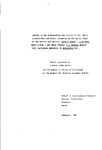ASPECTS OF THE DISTRIBUTION AND ECOLOGY OF GALL WASPS (HYMENOPTERA: CYNIPIDAE) OCCURRING ON THE AERIAL PARTS OF THE BRITISH OAK SPECIES (QUERCUS ROBUR L.,Q.PETRAEA (MATT.)LIEBL.) AND THEIR HYBRIDS (Q.x ROSACEA BECHST) WITH PARTICULAR REFERENCE TO NEUROTERUS SPP..
| dc.contributor.author | MARTIN, MICHAEL HENRY | |
| dc.contributor.other | School of Geography, Earth and Environmental Sciences | en_US |
| dc.date.accessioned | 2013-11-04T13:24:53Z | |
| dc.date.available | 2013-11-04T13:24:53Z | |
| dc.date.issued | 1980 | |
| dc.identifier | NOT AVAILABLE | en_US |
| dc.identifier.uri | http://hdl.handle.net/10026.1/2578 | |
| dc.description.abstract |
Mature oaks covering the full range of the indigenous Quercus species, from the oak woods of Dartmoor and its periphery, were sampled each month during the growing season for the presence of cynipid oak galls. The distributions of galls within sites, within trees and within leaves were recorded, and an investigation into the factors which affect them was made. The distributions of galls on oaks were found to be influenced by climatic and topographical factors as well as by the behaviour of the wasps and the taxonomic status of the host oak. Oaks in exposed situations tended to host more species of gall causing wasps, in higher numbers than oaks in sheltered situations within the woodland canopies. In addition; Q.robur hosts harboured more gall species and larger numbers of an individual species than Q.petraea hosts. Oaks of introgressed hybrid status (Q.x rosacea) had gall populations ranging from levels less than were found for Q.petraea to levels higher than occurred on Q.robur. Partitioning of gall species occurred both vertically and horizontally within the canopy, and within individual leaves. Work on the ecologies of the gall causing wasps indicate that the adults may be able to distinguish between the indigenous oak taxa, when selecting suitable oviposition sites. Some gall species are solely restricted to Q.robur, a situation probably determined by some unidentified physiological property of Q.robur favourable to cynipid gall induction. An investigation into the life cycle of Andricus quercuscalicis Burgsdorff, and its effects on the natural regeneration potential of oaks was also undertaken. Up to 100% of acorns on oaks infested by A.quercuscalicis may be galled, which has serious consequences on the subsequent germination potential of the acorns. Only one or two trees in a wood are infested by A.quercuscalicis in any year, and as long as this pattern exists it is not thought likely to pose a serious threat to the natural regeneration of oaks. | en_US |
| dc.language.iso | en | en_US |
| dc.publisher | University of Plymouth | en_US |
| dc.title | ASPECTS OF THE DISTRIBUTION AND ECOLOGY OF GALL WASPS (HYMENOPTERA: CYNIPIDAE) OCCURRING ON THE AERIAL PARTS OF THE BRITISH OAK SPECIES (QUERCUS ROBUR L.,Q.PETRAEA (MATT.)LIEBL.) AND THEIR HYBRIDS (Q.x ROSACEA BECHST) WITH PARTICULAR REFERENCE TO NEUROTERUS SPP.. | en_US |
| dc.type | Thesis | |
| plymouth.version | Full version: final and full version as approved by the examiners at the time of the award of your degree | en_US |
| dc.identifier.doi | http://dx.doi.org/10.24382/3748 | |
| dc.identifier.doi | http://dx.doi.org/10.24382/3748 |
Files in this item
This item appears in the following Collection(s)
-
01 Research Theses Main Collection
Research Theses Main


